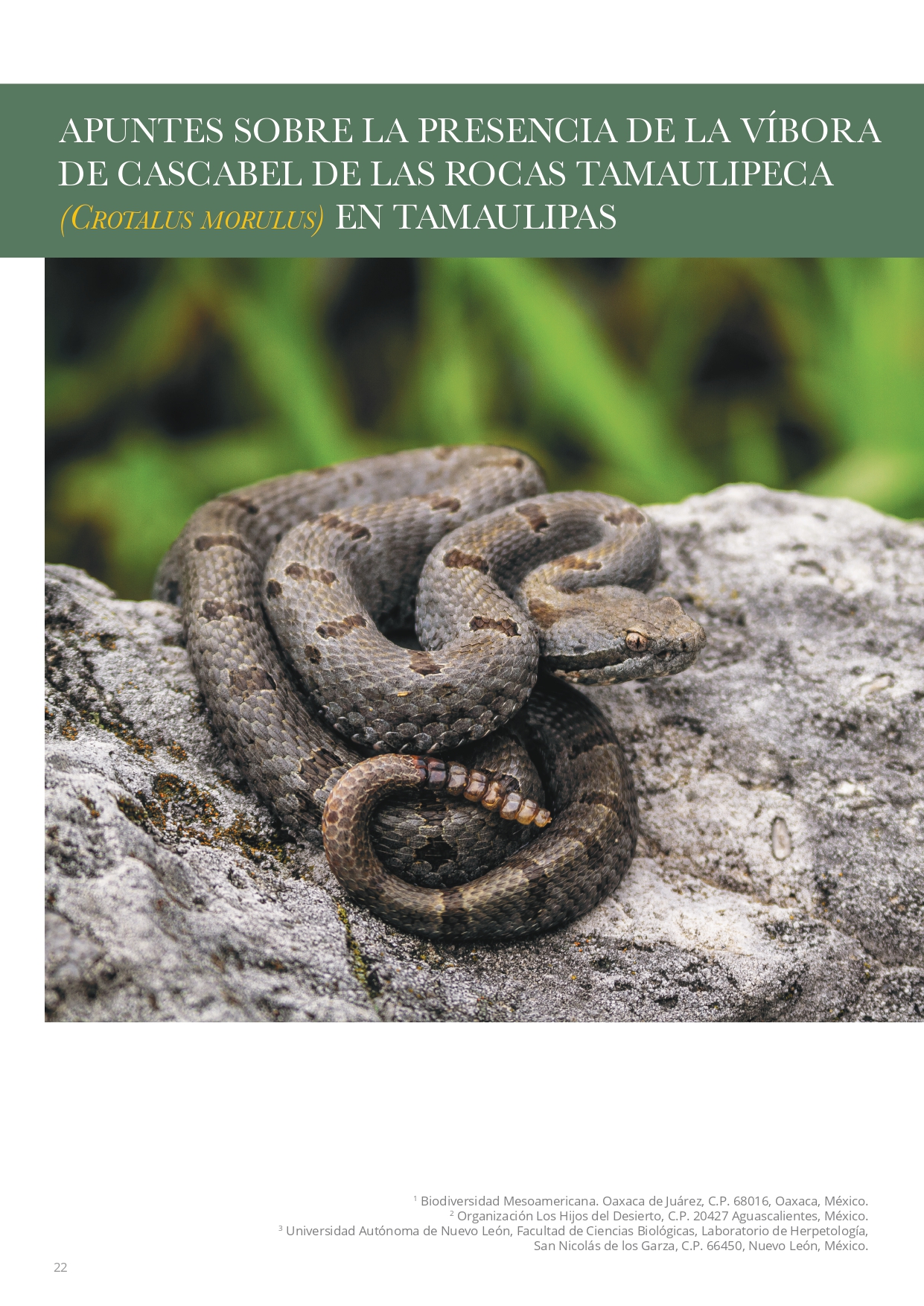Apuntes sobre la presencia de la víbora de cascabel de las rocas tamaulipeca (Crotalus morolus) en Tamaulipas
DOI:
https://doi.org/10.29105/bys7.13-103Palabras clave:
Crotalus morulus, Herpetofauna, El Cielo, Miquihuana, TamaulipasResumen
Documentamos anecdótica y fotográficamente la presencia de Crotalus morulus en el estado de Tamaulipas, así como de las especies que componen la herpetofauna asociada en el hábitat de esta emblemática especie de víbora en un par de localidades del sur de Tamaulipas. Observamos graves problemas ambientales en ambas áreas de estudio. Instamos a las autoridades e instituciones ambientales a promover las bases para la conservación efectiva a perpetuidad de esta especie y de los ecosistemas naturales en los que convive con un sinnúmero de especies nativas y endémicas que conforman el patrimonio biológico de la entidad más biodiversa del noreste de México.
Descargas
Citas
Caballero-Cruz, P., Herrera-Muñoz, G., Berriozabal-Islas, C., y Pulido, M. T. 2016. Conservación basada en la comunidad: importancia y perspectivas para Latinoamérica. Estudios Sociales. 48: 337-353.
Comisión Nacional de Áreas Naturales Protegidas. 2005. “Estudio Previo Justificativo para el establecimiento de la Reserva de la Biosfera Sierra de Tamaulipas”. México, D.F. Pp. 89.
Dirzo, R., y Raven, P. H. 2003. Global state of biodiversity and loss. Annual Review of Environment and Resources. 28: 137-167. DOI: https://doi.org/10.1146/annurev.energy.28.050302.105532
Gómez-Rodríguez, J.F., y Salazar-Olivo, C.A. 2012. Arañas de la región montañosa de Miquihuana, Tamaulipas: listado faunístico y registros nuevos. Dugesiana 19(1):1-7.
García-Alaniz, N., Eqihua, M., Pérez-Maqueo, O., Equihua-Benítez, J., Maeda, P., Pardo Urrutia, F., Flores-Martínez, J., Villela-Gaytán, S. A., y Schmidt, M. 2017. The Mexican national biodiversity and ecosystem degradation monitoring system. Current Opinion in Environmental Sustainability. 26: 62-68. DOI: https://doi.org/10.1016/j.cosust.2017.01.001
Heimes, P. 2016. Herpetofauna Mexicana Vol. 1. Snakes of Mexico. Edition Chimaira, Frankfurt am Main. Pp.572.
Johnson, J.D., Wilson, L.D., Mata-Silva, V., García-Padilla, E., y DeSantis, D.L. 2017. The endemic herpetofauna of Mexico: organisms of global significance in severe peril. Mesoamerican Herpetology 4: 543–620.
Klauber, L.M. 1952. Taxonomic studies on rattlesnakes of Mainland Mexico. Bulletins of the Zoological Society of San Diego (26): 1-143. DOI: https://doi.org/10.5962/bhl.title.130475
Klauber, L.M. 1997. Rattlesnakes: Their Habitats, Life Histories, and Influence on Mankind. Second Edition.
First published in 1956, 1972. University of California Press, Berkeley.
Lazcano, D., Banda-Leal, J., Castañeda-Gaytán, G., García de la Peña, C., y Bryson, R.W. 2004a. Crotalus lepidus (Tamaulipean Rock Rattlesnake) Diet. Herpetological Review. 35(1): 62-63.
Lazcano, D., Contreras-Balderas, A., González-Rojas, J.I. Castañeda-Gaytán, G., García-de la Peña, C., y Solís-Rojas, C. 2004b. Notes on Herpetofauna # 6: Herpetofauna of the Sierra San Antonio Peña Nevada, Zaragoza, Nuevo León, Mexico: Preliminary List. Bulletin Chicago Herpetological Society 39 (10): 181-187.
Lazcano, D., Pacheco-Treviño, S., Nevárez de los Reyes, M., Banda-Leal, J., y Barriga-Ibarra, C. 2015a. Notes on Mexican Herpetofauna # 25: Association of Herpetofauna with Agaves in the States of Nuevo Leon and Tamaulipas, Mexico. Bulletin of the Chicago Herpetological Society 50(6):77-86.
Lazcano, D., y Pacheco-Treviño, S. 2015b. Sierra San Antonio Peña Nevada, Zaragoza, Nuevo León: La Herpetofauna y los Agaves de la Sierra. Planta Año 9 (19): 26-32. Universidad Autónoma de Nuevo León. Julio-Diciembre 2014.
López-Barrera, F., Martínez-Garza, C., y Ceccon, E. 2017. Ecología de la restauración en México: estado actual y perspectivas. Revista Mexicana de Biodiversidad 88: 87-112. DOI: https://doi.org/10.1016/j.rmb.2017.10.001
Macouzet-Pacheco, M.V., Estrada-Castillón, E., Jiménez- Pérez, J., Villarreal-Quintanilla, J.A., y Herrera-Monsiváis, M.C. 2013. Plantas Medicinales de Miquihuana, Tamaulipas. Facultad de Ciencias Forestales, Universidad Autónoma de Nuevo León, México.
Martin, P. S. 1955. Herpetological records from the Gómez Farías region of southwestern Tamaulipas, México. Copeia 1955(3): 173–180. DOI: https://doi.org/10.2307/1440457
Martin, P. S. 1958. A biogeography of reptiles and amphibians in the Gómez Farias region, Tamaulipas, Mexico. Miscellaneous Publication, Museum of Zoology, University of Michigan 101: 1–102. DOI: https://doi.org/10.3998/mpub.9690701
Plascencia, R.L., Castañón Barrientos, A., y Raz-Guzmán, A. 2011. La biodiversidad en México su conservación y las colecciones Biológicas Ciencias, Universidad Nacional Autónoma de México 101:36-43.
Price, S. M. 2014. Guide to the Rock Rattlesnakes of Mexico. ECO Publishing. Pp. 121.
Sarukhán, J. et al., 2017. Capital natural de México. Síntesis: evaluación del conocimiento y tendencias de cambio, perspectivas de sustentabilidad, capacidades humanas e institucionales. Comisión Nacional para el Conocimiento y Uso de la Biodiversidad, México.
SEMARNAT. 2019. MODIFICACIÓN del Anexo Normativo III, Lista de especies en riesgo de la Norma Oficial Mexicana NOM-059-SEMARNAT-2010, Protección ambiental-Especies nativas de México de flora y fauna silvestres-Categorías de riesgo y especificaciones para su inclusión, exclusión o cambio-Lista de especies en riesgo, publicada el 30 de diciembre de 2010.
Terán-Juárez, S. A., E. García-Padilla, E., Mata-Silva, V., Johnson, J.D., y Wilson, L.D. 2016. The herpetofauna of Tamaulipas, Mexico: composition, distribution, and conservation. Mesoamerican Herpetology 3: 43–113. Terán-Juárez, S. A., García-Padilla, E. Leyto-Delgado, F.E., y García-Morales, L.J. 2015. Distribution Notes. New records and distributional range extensions for amphibians and reptiles from Tamaulipas, Mexico.
Mesoamerican Herpetology 2: 208– 214.
Toussaint. A. 2015. México Megadiverso. Un Poema de Vida SEMARNAT. Pp.359.
Wilson, L. D., Mata-Silva, V., y Johnson, J.D. 2013a. A conservation reassessment of the reptiles of Mexico based on the EVS measure. Special Mexico Issue. Amphibian & Reptile Conservation 7: 1–47.
Wilson, L. D., Johnson, J.D., y Mata-Silva, V 2013b. A conservation reassessment of the amphibians of Mexico based on the EVS measure. Special Mexico Issue. Amphibian & Reptile Conservation 7: 97–127.

Descargas
Publicado
Cómo citar
Número
Sección
Categorías
Licencia
Derechos de autor 2024 Eli García-Padilla, Iván Villalobos-Juárez, David Lazcano

Esta obra está bajo una licencia internacional Creative Commons Atribución 4.0.





